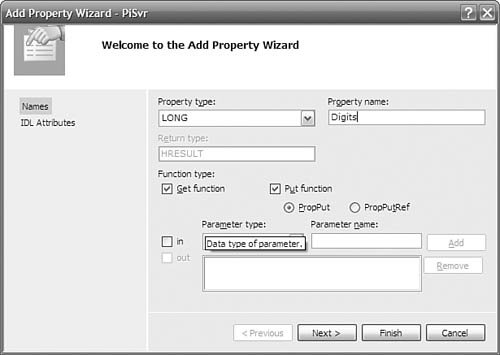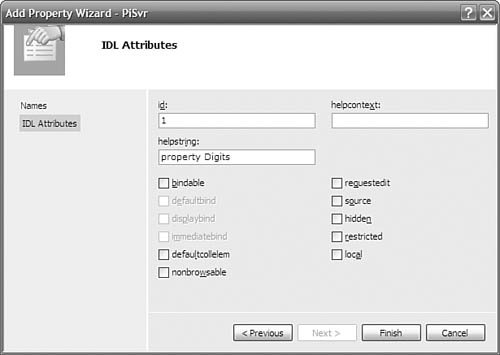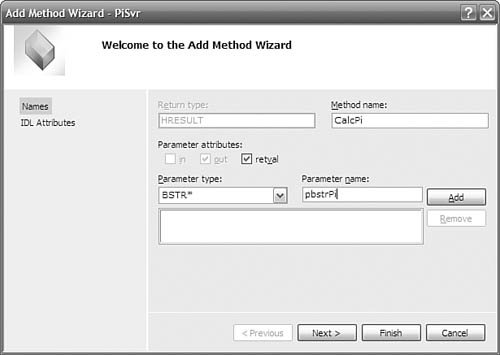Adding Properties and MethodsOne of the things that make a C++ programmer's life hard is the separation of the class declaration (usually in the .h file) and the class definition (usually in the .cpp file). This can be a pain because of the maintenance required between the two. Any time a member function is added in one, it has to be replicated in the other. Manually, this can be a tedious process, and it is made even more tedious for a C++ COM programmer who must maintain the same definitions in an .idl file. When I'm adding properties and methods to my interfaces, I'd like my C++ development environment to help translate an IDL method definition into C++ (with the appropriate ATL attributes, if necessary) and drop it into my .h and .cpp files for me, leaving me a nice place to provide my implementation. That's just what Visual Studio provides. By right-clicking on a COM interface in Class view, you can choose to add a new property or method from the Add submenu of the context menu that appears. Figure 1.7 shows the dialog box that enables you to add a property to a COM interface. Parameters to the property can be added by specifying the parameter data type and the parameter direction (for example, [in] or [out]). Figure 1.7. Adding a property

Figure 1.8 shows the options available on the IDL Attributes tab for the Add Property Wizard. Selected attributes are inserted into the appropriate interface definition, in your project's IDL file. In either case, the effect on the type library is identical. Many of these attributes apply in rare circumstances, so the default selections and values shown in the figure are often suitable. In any event, adding, deleting, or modifying these attributes directly in the IDL file afterward is a simple matter.
Figure 1.8. IDL attributes for a property

The following shaded code shows the implementation skeleton that the wizard generates. We have to provide only the appropriate behavior (shown as unshaded code). STDMETHODIMP CCalcPi::get_Digits(LONG* pVal) { *pVal = m_nDigits; return S_OK; } STDMETHODIMP CCalcPi::put_Digits(LONG newVal) { if( newVal < 0 ) return Error(L"Can't calculate negative digits of PI"); m_nDigits = newVal; return S_OK; } Similarly, we can add a method by right-clicking an interface in Class view and choosing Add Method. Figure 1.9 shows the Add Method Wizard. Input and output parameters are added individually using the Parameter Type combo box, the Parameter Name text box, and the Add/Remove buttons.
Figure 1.9. Adding a method

Again, the wizard updates the interface definition in either the IDL file or the header file, generates the appropriate C++ code, and places us in the implementation skeleton to do our job. The shaded code is what remains of the wizard-generated C++ code after I added the code to implement the method: STDMETHODIMP CCalcPi::CalcPi(BSTR* pbstrPi) { _ASSERTE(m_nDigits >= 0); if( m_nDigits ) { *pbstrPi = SysAllocStringLen(L"3.", m_nDigits+2); if( *pbstrPi ) { for( int i = 0; i < m_nDigits; i += 9 ) { long nNineDigits = NineDigitsOfPiStartingAt(i+1); swprintf(*pbstrPi + i+2, 10, L"%09d", nNineDigits); } // Truncate to number of digits (*pbstrPi)[m_nDigits+2] = 0; } } else { *pbstrPi = SysAllocString(L"3"); } return *pbstrPi ? S_OK : E_OUTOFMEMORY; } For a description of COM exceptions and the ATL Error function (used in the put_Digits member function), see Chapter 4, "Objects in ATL." |